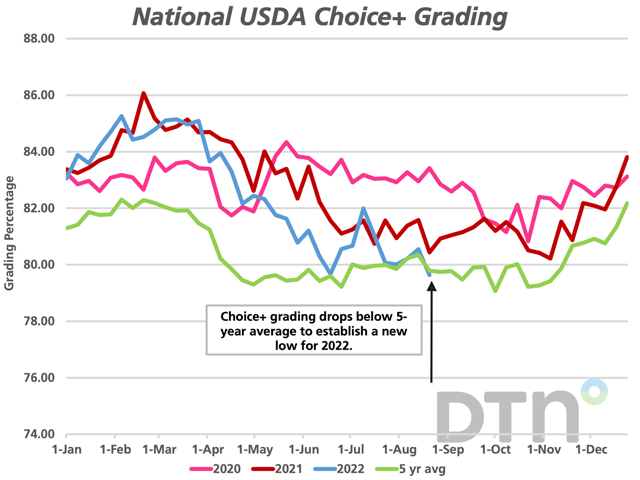Call the Market
Choice/Prime USDA Grading Percentage Falls Below Five-Year Average, Establishes New Low for 2022
To many, this past week's trade felt like an undeserved gut-wrenching blow as both the live cattle and feeder cattle markets traded lower despite having stormed higher during the last three weeks. Disappointing reports about this year's corn crop left the corn complex rallying as its yields are expected to be weaker than initially assumed and far more of the crop has damage than originally believed. This sent the cattle complex plummeting as concerns about higher feed costs are no friend to the cattle market.
But even with corn's recent rise, it would be both negligent and careless for us to overlook the impressive carcass grading data that came out early this week.
Monday's most recent USDA Grading data shared that the nation's choice and prime grading carcasses fell below the market's five-year average and also carved out a new low for the 2022 calendar year with only 79.64% of cattle grading choice or better.
P[L1] D[0x0] M[300x250] OOP[F] ADUNIT[] T[]
Of the three biggest feeding regions, Texas saw the biggest week-over-week decline as steers and heifers in its region only averaged 66.50% choice or better (falling 2.85% from the previous week). Whereas Nebraska's grading percentage only fell by 0.94% from the previous week to average 80.84% choice or better, and Kansas saw the smallest week-over-week change as its region averaged 80.45% choice or better, which was a 0.12% increase from the prior week.
To fully understand the mechanics of beef quality grades, it's important that we spend a little time defining what quality grades are, and how different factors influence how cattle will grade.
Certified Angus Beef explains quality grading as, "Beef carcasses at graded plants are assigned a USDA Quality Grade and a USDA Yield Grade. Quality grades for market steers and heifers are, in descending order of quality: prime, choice, select and standard. These grades are determined by a USDA grader, or by a camera which captures a digital image. Quality grade is a visual, or in the case of a camera a digitized, image of the amount of marbling, or intramuscular fat in the ribeye. Approximately 24 hours after harvest/slaughter, the carcass is 'ribbed' between the 12th and 13th rib and that open face of the ribeye muscle (longissimus dorsi) is exposed to the USDA grader.
"The more marbling, or 'flecks' of white fat in the muscle helps determine the quality grade. The amount of marbling in the meat determines quality because it adds more taste and juiciness to the product. A highly marbled ribeye will be stamped 'Prime' or may have three little USDA stamps on it. A carcass that has a little less marbling will be stamped 'Choice' or may have two small USDA stamps put on it; a 'Select' carcass has very little marbling and will get stamped as such, or with one small USDA stamp. A USDA 'Standard' carcass has practically no marbling in it. Considered the lowest quality, it is often referred to as a 'no-roll' (graders used to use a rolling stamp on carcasses that showed what quality grade the carcasses were; those with no 'roll' of grade on it were 'Standards' or, again, 'no-rolls'," stated Certified Angus Beef.
The reason why it's so important that the market, especially feedlots looking to market fat cattle in the weeks/months ahead, absorb the most recent grading information is because this highlights that front-end supplies of market-ready cattle are shrinking.
The market's most recent carcass data, for the week ended Aug. 13, shows steers averaged 901 pounds (up 9 pounds from the previous week, and up 3 pounds from a year ago); for the same week, heifers averaged 822 pounds (up 8 pounds from a week ago, and up 5 pounds from a year ago). One could argue that these two points unravel one another. How can carcasses be growing, but grading percentage waning? And while I raise a brow at the most recent carcass data and question its findings, higher carcass weights don't dismantle the fact that grading percentages are falling as days on feed affect grading too; also, today cattle genetically possess bigger carcasses.
In conclusion, given the aggressive throughput the industry has seen this year, it should come as no surprise that cattle are being pulled ahead of schedule to meet processing needs, which therefore leads to fewer days on feed, lighter marbling, and fewer cattle grading choice or better. It's likely the cash cattle market sees pressure again this week as packers use the upcoming Labor Day holiday to pump the brakes on the cash cattle market's rally. But given what we know about showlists and grading percentages, feedlots will sit in the driver's seat of the market again soon as front-end currentness is growing.
ShayLe Stewart can be reached at ShayLe.Stewart@dtn.com
(c) Copyright 2022 DTN, LLC. All rights reserved.






